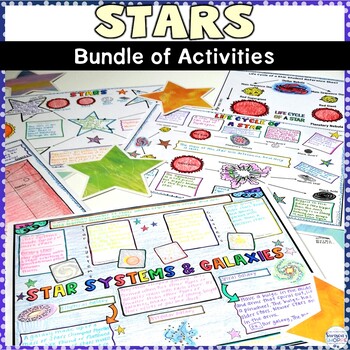Star Systems and Galaxies Activity Unit
- Zip
- Google Apps™

What educators are saying
Products in this Bundle (3)
Bonus
Description
Introduce your earth science students to stars, star systems, and galaxies with the included reading worksheets and doodle sketch note graphic organizers. Students will read to learn about the characteristics, life cycle, and types of stars as well as the different types of galaxies. Digital activities are now included!
Like this resource? Click here to check out the earth science bundle and save over 20%.
Students will learn:
- About the characteristics of a star
- Composition
- Size
- Color and temperature
- Brightness: absolute and apparent brightness
- The life cycle of a star
- Includes nebula, protostar, track for low and high mass stars: red giant, planetary nebula, white dwarf, black dwarf, supergiant, supernova, black hole, neutron star
- What is a star system?
- Different star systems and clusters
- Binary star
- Eclipsing binary
- Open cluster
- Globular cluster
- What are the major galaxies?
- Irregular galaxy
- Spiral galaxy
- Milky Way
- Elliptical galaxy
This unit includes:
- Sneak Peek into My Classroom pages: Read to learn how I teach this lesson in my own classroom. This is a multipage teacher sheet that includes ideas of ways to engage your students while they are using the materials as well as pictures of the strategies in action in my classroom.
- Links to Quizlet to practice vocabulary
- 7 pages of science worksheets will give students background information on the characteristics and life cycle of a star.
- A life cycle of a star diagram
- The life cycle of a star review activity
- 3 graphic organizers:
- Characteristics of a star
- Hertzsprung - Russell diagram (HR diagram)
- The life cycle of a star
- Vocabulary sheet
- 3-page science reading about galaxies and star systems
- Comprehension questions
- Digital Google Slide link to a 24 slide digital DINB notebook to learn about the characteristics of a star, the life cycle of a star, star systems, clusters, and galaxies
- Graphic organizer
- Link to Quizizz to review star systems and galaxies with your students
- Digital Escape Activity
- Answer key
Feedback from happy teachers:
- Love Love Love all of your sketch notes!
- Excited to use these!
- Great resource.
Other activities and lessons you might be interested in:
Kindly Note: If you have questions, please email me at Teaching Muse Email.
PLEASE PREVIEW BEFORE PURCHASING
____________________________________________________________________________________
Thank you for visiting Teaching Muse. I would love for you to become a follower.
Teaching Muse followers receive new product information and discounts on any new items!
____________________________________________________________________________________
All rights reserved by Teaching Muse. This product is to be used by the original downloader ONLY. Copying for more than one teacher, classroom, department, school, or school system is prohibited. Additionally, this product may not be distributed or displayed digitally for public view. Failure to comply is a copyright infringement and violates the Digital Millennium Copyright Act (DMCA). Intended for classroom and personal use ONLY.





